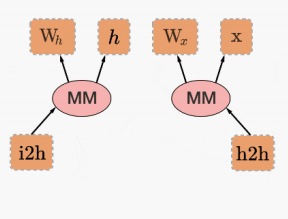目前神经网络框架分为静态图框架和动态图框架,PyTorch和TensorFlow、Caffe等框架最大的区别就是他们拥有不同的计算图表现形式。TensorFlow1.*使用静态图(在TensorFlow2.*中使用的是动态图),这意味着我们先定义计算图,然后不断使用它,而在PyTorch中,每次都会重新构建一个新的计算图。
静态图和动态图有各自的优点。动态图比较方便DEBUG,使用者能够使用任何他们喜欢的方式进行debug,同时非常直观,而静态图是通过先定义后运行的方式,之后再次运行的时候就不再需要重新构建计算图,所以速度会比动态图更快。
import torch
from torch.autograd import Variable
x=Variable(torch.randn(1,10))
prev_h=Variable(torch.randn(1,20))
W_h=Variable(torch.randn(20,20))
W_x=Variable(torch.randn(20,10))
i2h=torch.mm(W_x,x.t())
h2h=torch.mm(W_h,prev_h.t())

比较while循环语句在TensorFlow和PyTorch中的定义
TensorFlow
import tensorflow as tf
first_counter=tf.constant(0)
second_counter=tf.constant(10)
def cond(first_counter,second_counter,*args):
return first_counter<second_counter
def body(first_counter,second_counter):
first_counter=tf.add(first_counter,2)
second_counter=tf.add(second_counter,1)
return first_counter,second_counter
c1,c2=tf.while_loop(cond,body,[first_counter,second_counter])
with tf.Session() as sess:
counter_1_res,counter_2_res=sess.run([c1,c2])
print(counter_1_res)
print(counter_2_res)
可以看到TensorFlow需要将整个图构成静态的,每次运行的时候图都是一样的,是不能够改变的,所以不能直接使用Python的while循环语句,需要使用辅助函数tf.while_loop写成TensorFlow内部形式。
PyTorch
import torch
first_counter=torch.Tensor([0])
second_counter=torch.Tensor([10])
while(first_counter<second_counter):
first_counter+=2
second_counter+=1
print(first_counter)
print(second_counter)

可以看到PyTorch的写法和Python的写法是完全一致的,没有任何额外的学习成本。
动态图的方式更加简单且直观。